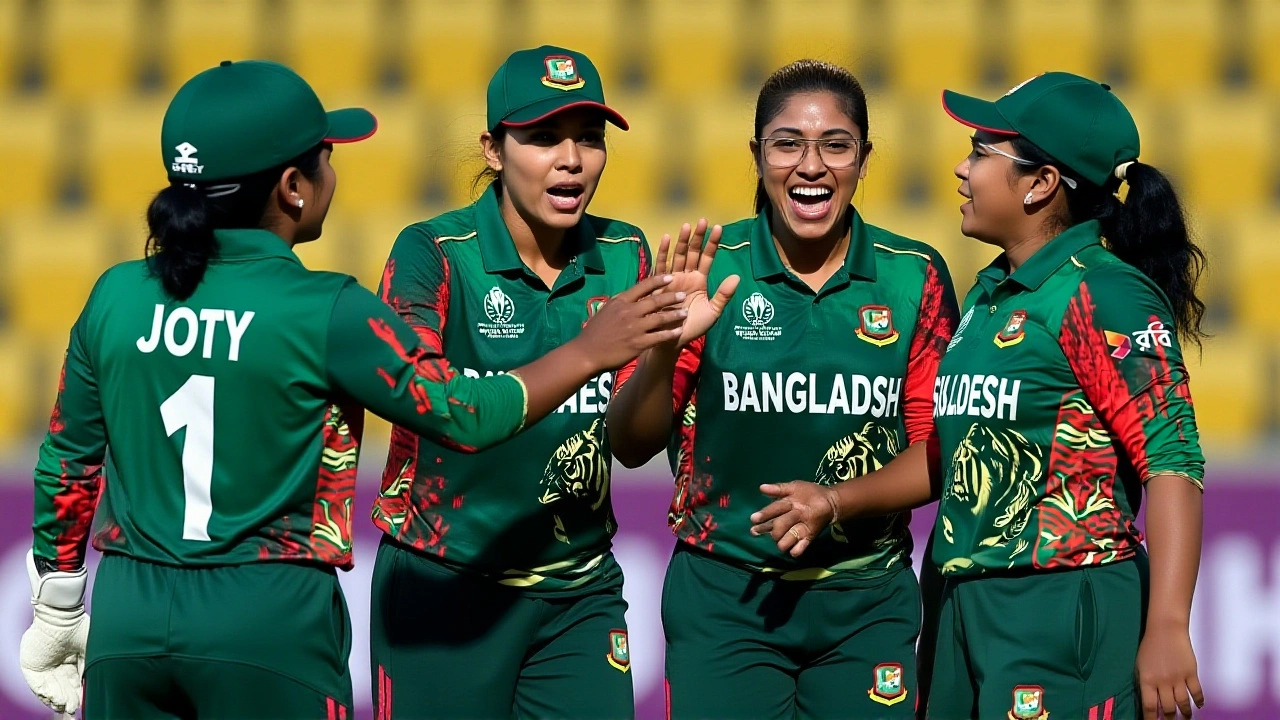When Sophie Devine, captain of the New Zealand Women's Cricket Team (the White Ferns), walked out to the crease at Assam Cricket Association Stadium in Guwahati on 10 October 2025, she already knew the stakes. The match was part of the ICC Women's Cricket World Cup 2025India, and New Zealand needed a win to snap a two‑match losing streak. White Ferns showed up ready, posting 227 / 9 before bowing out, while Bangladesh managed just 127 all out – a 100‑run drubbing that reshaped the group.
Match overview
The toss gave New Zealand the privilege to bat first. Devine chose to set a target, and she delivered a solid 63‑run knock, anchoring the innings after opener Brooke Halliday laid down a steady 52. The partnership steadied the White Ferns through the middle overs, allowing the lower order to add valuable runs. By the end of the 50‑over spell, the scoreboard read 227 / 9.
Bangladesh’s reply never found a rhythm. They slumped to 33 / 6 inside the first 14 overs, and never recovered. Their total of 127 fell in 39.3 overs, handing New Zealand a 100‑run victory – the biggest margin the Ferns have ever enjoyed against Bangladesh in a World Cup.
Key performances
Beyond Devine’s bat, the bowling unit was the story. Right‑arm fast bowler Leah Grace Tahuhu and right‑arm medium‑fast Jess Kerr each snagged three wickets, ripping through the top order during the powerplay. Medium‑pacer Rosemary Mair added two more, while spinner Amelia Kerr and off‑spinner Eden Carson each claimed a wicket, including the dismissal of Bangladesh captain Nigar Sultana Joty.
- Devine (63) – top‑order stability
- Halliday (52) – solid opening partnership
- Tahuhu & Kerr (3 wkts each) – early breakthroughs
- Mair (2 wkts) – containment in middle overs
- Kerr (Amelia) & Carson (1 wkts each) – neat end‑over finishes
Bangladesh's batting collapse
Bangladesh entered the chase with confidence after a three‑wicket win over Pakistan on 7 October 2025. Yet the white‑ball attack at Guwahati ripped their top order apart. Early figures of 33 / 6 painted a grim picture, and only three batters crept into double figures: Fahima Khatun (31), Nahida Akter (12) and Rabeya Khan (17). The lack of partnerships meant the pressure never eased, and wickets fell at regular intervals.
Coach Dimuth Karunaratne
"We lost too many wickets early and couldn't build partnerships. We need to bounce back strongly against South Africa," he said after the match, acknowledging the urgency of regrouping.
Reactions from coaches and players
New Zealand head coach Ben Lister praised the all‑round effort, especially the new‑ball pairing of Jess Kerr and Rosemary Mair. "The bowlers executed the plan perfectly. The early wickets gave us the platform to defend comfortably," Lister noted.
On the Bangladeshi side, captain Nigar Sultana Joty admitted the batting line‑up struggled with the swing and seam movement. "The conditions were tough, but we have to learn fast," she remarked, hinting at tactical adjustments before the South Africa clash.

Implications for the group stage
With the win, the White Ferns climb to two points, overtaking both Australia and England, who sit on one point each after their opening games. The victory also ends a three‑match slump that saw New Zealand lose to Australia and England earlier in the tournament.
Bangladesh, now with a single point, must win against South Africa to keep any hope of advancing. Their net run rate has taken a hit, and the upcoming match at Brabourne Stadium will be a make‑or‑break encounter.
Looking ahead
New Zealand’s next fixture is against Sri Lanka on 14 October 2025 at the iconic Wankhede Stadium in Mumbai. With momentum on their side, the Ferns will aim to consolidate their position at the top of the group.
Bangladesh, meanwhile, travels to Brabourne Stadium for a crucial showdown with South Africa on 13 October 2025. A win would not only revive morale but also tighten the points table.
Key facts
- Date: 10 October 2025
- Venue: Assam Cricket Association Stadium, Guwahati, India
- Result: New Zealand 227 / 9, Bangladesh 127 (39.3 overs) – New Zealand win by 100 runs
- Top scorer: Sophie Devine – 63 runs
- Best bowling figures: Leah Tahuhu and Jess Kerr – 3 wickets each
Frequently Asked Questions
How does this win affect New Zealand’s chances of reaching the quarter‑finals?
The victory lifts the White Ferns to two points, putting them ahead of several rivals in Group A. With a superior net run rate and two matches remaining, New Zealand now sits in a strong position to qualify, needing just one more win to secure a top‑two finish.
What were the main reasons behind Bangladesh’s batting collapse?
Early swing and seam from New Zealand’s new‑ball bowlers rattled the top order, leading to a 33 / 6 scoreboard after 14 overs. In addition, a lack of substantial partnerships and a tentative approach to the chase compounded the pressure, resulting in an all‑out for 127.
Who are the standout performers for New Zealand in this match?
Captain Sophie Devine led with a crisp 63, while opener Brooke Halliday contributed 52. On the bowling side, Leah Tahuhu and Jess Kerr each captured three wickets, and Rosemary Mair added two, making the bowling attack the decisive factor.
When and where is Bangladesh’s next match?
Bangladesh faces South Africa on 13 October 2025 at the Brabourne Stadium in Mumbai, India. The result will be crucial for their hopes of staying in contention for the knockout stage.
What does this result mean for the tournament’s viewership?
A decisive win like this boosts global interest, especially with broadcasters such as Star Sports, Sky Sports and SuperSport promoting the drama. Higher viewership numbers are expected for the upcoming matches in Mumbai.


Comments (12)
Wow, the White Ferns really set the stage on fire in Guwahati! Sophie Devine’s 63 was the perfect blend of power and poise, and the early wickets from Tahuhu and Jess Kerr turned the match into a one‑sided thriller. Bangladesh never found a rhythm, crumbling under the swing like a house of cards. This 100‑run drubbing isn’t just a win; it’s a statement that New Zealand is back in the hunt. The momentum shift is palpable, and the group table is already feeling the tremors.
yeah, that was a blowout.
Let’s be clear: Bangladesh’s batting collapsed because they failed to adjust to the seam movement early on. Tahuhu and Kerr exploited the new‑ball swing flawlessly, and the Bangladeshi top order never built any partnerships. Their scoring rate stalled, and the pressure mounted with each wicket. A disciplined bowlers’ plan combined with tight field placements forced errors at the crease. If they want to stay competitive, they must overhaul their technique against moving ball and rotate the strike more effectively. Otherwise, they’ll continue to bleed runs in the group stage.
It’s impressive to see how New Zealand’s cricketing culture blends aggression with sportsmanship, especially in a sub‑continental setting like Guwahati. The fans here got a spectacular display, and the atmosphere was electric, showcasing the love for women’s cricket across borders.
Indeed, the match highlighted a stark contrast between the strategic depth of the Ferns and the fragile foundation of Bangladesh’s lineup. While New Zealand executed a meticulously crafted game plan, Bangladesh appeared unprepared for the nuanced swing and seam variations, leading to a precipitous collapse. This disparity underscores the importance of adaptive training regimes tailored to diverse pitch conditions.
Wow!!! What a game!!! The Ferns really showed their mettle!!! Bangladesh just couldn't keep up!!! The swings were just too much!!!
The statistical edge was clear; NZ’s net run rate surged while Bangladesh’s plummeted, making the group dynamics shift dramatically.
yeah its kinda obvious tbh they dominated from start to end
Bangladesh needs better top‑order techniques against swing.
While the observation is technically accurate, it fails to acknowledge the systemic deficiencies within Bangladesh’s coaching infrastructure that perpetuate such shortcomings, thereby rendering the comment superficial.
Could we also consider how the differing pitch preparations between sub‑continental venues and New Zealand’s home grounds affect team strategies? It would be valuable to explore adaptive training methods that bridge this gap.
i think u r right its kinda like they need more practice on swing like our domestic leagues do but also need mental toughness lol